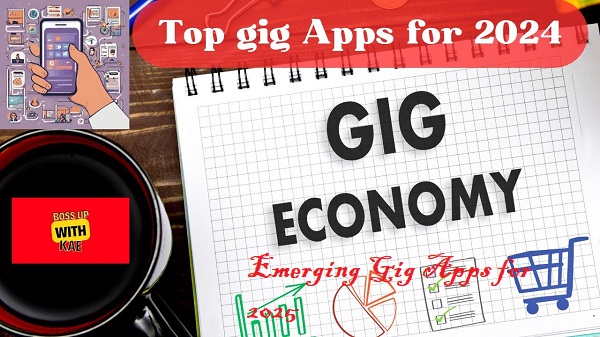As we approach 2025, the gig economy is expanding quickly, fueled by technological advancements and the changing nature of labor. With more people looking for flexible, project-based work, gig apps are playing an important role in connecting freelancers with customers.
While existing platforms such as Uber, Lyft, and Fiverr remain popular, a new wave of gig apps is emerging that provide unique services, improved user experiences, and targeted opportunities for certain regions.
In this article, we’ll look at the top emerging gig apps for 2025, which are projected to transform the freelance environment by giving workers with new and different ways to earn money.

1. GigSmart – A Comprehensive Marketplace for On-Demand Workers
GigSmart is rapidly gaining traction as a go-to platform for on-demand workers across various industries. It connects individuals looking for temporary work with companies and consumers in need of their services. What sets GigSmart apart from traditional gig platforms is its focus on providing a wide range of opportunities, from skilled labor and construction work to food delivery and customer service.
Benefits & Pros: GigSmart’s unique selling point lies in its versatility. It allows users to create customized profiles that showcase their skills, certifications, and availability. The app also offers advanced filters, making it easier for companies to find the right candidate for specialized tasks.
In addition to short-term gigs, GigSmart also offers a feature called “Get Workers,” enabling businesses to hire workers for long-term projects or full-time positions. With competitive fees and a user-friendly interface, GigSmart is expected to attract a growing number of freelancers and businesses by 2025.
2. Steady – Empowering Freelancers to Maximize Income
Steady is an innovative gig app designed to help freelancers increase their income by offering a personalized approach to finding gigs. What makes Steady unique is its focus on financial stability and maximizing earnings for freelancers. The app uses AI-driven tools to match users with gig opportunities that align with their skills and financial goals.
Benefits & Pros: Steady offers a variety of features that go beyond job matching. Freelancers can track their earnings in real-time, set income goals, and receive recommendations for gigs based on their financial needs. The platform also provides access to financial health resources, such as low-cost insurance, budgeting tools, and emergency cash grants.
By 2025, Steady is expected to play a pivotal role in helping gig workers navigate the complexities of the freelance economy, empowering them to achieve greater financial independence.
3. TaskRabbit – Expanding into New Markets
TaskRabbit, a well-established name in the gig economy, continues to evolve and expand into new markets. Originally focused on connecting individuals with local tasks such as furniture assembly, cleaning, and handyman services, TaskRabbit has broadened its scope to include a wider range of gig opportunities. This expansion has been fueled by partnerships with major retailers like IKEA, allowing the app to tap into new customer bases.
Benefits & Pros: In 2025, TaskRabbit is set to introduce new categories, such as virtual assistance, home design consulting, and tech support. These developments reflect the platform’s commitment to adapting to the changing demands of consumers while providing freelancers with a broader spectrum of job opportunities.
TaskRabbit’s continued growth and diversification make it a key player in the gig economy for years to come.
4. Wonolo – Revolutionizing Shift-Based Work
Wonolo is a gig app that specializes in connecting workers with shift-based jobs in industries such as warehousing, manufacturing, and retail. The platform allows companies to post open shifts, and workers can claim those that fit their schedule and skill set. Unlike other gig platforms that focus on freelance or project-based work, Wonolo is built for hourly workers seeking flexible shift options.
Benefits & Pros: What sets Wonolo apart is its commitment to fair labor practices. The platform ensures that workers are paid promptly after completing their shifts and offers a rating system that promotes accountability for both workers and employers. Wonolo has also implemented benefits like access to healthcare plans and career development resources, making it an attractive option for those seeking gig work with added security.
As more businesses adopt flexible workforce models, Wonolo is expected to see significant growth in 2025, particularly in industries reliant on seasonal or part-time labor.
5. Dumpling – Empowering Independent Entrepreneurs
Dumpling is an emerging gig app that stands out for its focus on empowering independent entrepreneurs in the grocery delivery space. Unlike traditional grocery delivery platforms like Instacart, which take a significant cut of workers’ earnings, Dumpling enables workers to build their own grocery shopping and delivery businesses. Freelancers on Dumpling set their own prices, manage their customer relationships, and retain a larger portion of their earnings.
Benefits & Pros: Dumpling provides its users with tools such as a mobile app, business coaching, and marketing resources, helping freelancers grow their independent businesses. This model gives workers more control over their careers while providing a higher earning potential compared to traditional delivery platforms.
By 2025, Dumpling is expected to attract a growing number of gig workers who are seeking to build sustainable, customer-focused businesses within the gig economy.
6. Pared – Specializing in the Hospitality Industry
Pared is an emerging gig platform tailored specifically for the hospitality industry. The app connects restaurants, bars, and hotels with skilled workers for temporary roles, such as chefs, bartenders, and waitstaff. Given the high turnover and fluctuating staffing needs in the hospitality sector, Pared provides businesses with a flexible solution for filling shifts on short notice.
Benefits & Pros: What makes Pared stand out is its vetting process. Workers on the platform are required to have relevant experience and certifications, ensuring that businesses receive qualified professionals for their needs. The app also allows workers to create detailed profiles, showcasing their skills, work history, and availability.
With the hospitality industry continuing to rebound from the impacts of the COVID-19 pandemic, Pared is expected to become an indispensable resource for both workers and employers in 2025.
7. Sling – Streamlining Workforce Scheduling
Sling is a gig app focused on simplifying workforce scheduling for businesses. While it’s not a traditional gig platform in the sense of matching freelancers with clients, Sling addresses a key challenge in the gig economy: managing schedules for shift-based workers. The app allows businesses to create, manage, and distribute work schedules efficiently, ensuring that shifts are filled without confusion or conflict.
Benefits & Pros: Sling is particularly useful for industries with large, dynamic workforces, such as retail, healthcare, and hospitality. Workers can view their schedules, swap shifts with colleagues, and communicate with managers through the app, reducing the need for manual scheduling processes.
By 2025, Sling is expected to be an essential tool for gig workers and employers alike, offering a more organized and streamlined approach to workforce management.
8. Helpling – The Future of On-Demand Home Services
Helpling is a rising star in the gig economy, offering a platform that connects consumers with home service professionals. Whether someone needs a cleaner, a gardener, or a handyman, Helpling provides a seamless way to book trusted professionals for home-related tasks. The app’s comprehensive vetting process ensures that only qualified workers are available for hire.
Benefits & Pros: What sets Helpling apart from other gig apps is its focus on sustainability. The platform emphasizes eco-friendly cleaning practices and encourages workers to use environmentally safe products. This approach resonates with consumers who are increasingly conscious of their environmental impact.
In 2025, Helpling is poised to become a leading gig platform for home services, particularly as demand for sustainable, on-demand solutions continues to grow.
9. Poparazzi – Gigs in the Creator Economy
With the rapid growth of the creator economy, Poparazzi is an emerging gig app that caters specifically to social media influencers and content creators. The app connects creators with brands looking for partnerships, enabling influencers to monetize their platforms through sponsored content, collaborations, and promotional gigs.
Benefits & Pros: Poparazzi also offers a marketplace where creators can hire freelance photographers, videographers, and editors to help produce high-quality content. By streamlining the process of finding brand deals and content creation support, Poparazzi is expected to play a significant role in the evolving creator economy.
By 2025, as the demand for influencer marketing continues to rise, Poparazzi will likely become a key platform for both creators and brands seeking to capitalize on the power of social media.
10. Maven – Specialized Gig Work for Healthcare Professionals
Maven is an emerging gig app that caters to healthcare professionals, providing temporary work opportunities for nurses, physicians, and allied health workers. As the healthcare industry continues to face staffing shortages and fluctuating demand, Maven allows workers to find short-term gigs at hospitals, clinics, and telehealth services.
Benefits & Pros: What makes Maven unique is its focus on healthcare-specific needs, offering workers access to continuing education, certification renewals, and career development resources. The platform ensures that all workers meet industry regulations and qualifications, providing peace of mind for both healthcare providers and patients.
In 2025, Maven is expected to become a vital resource for healthcare professionals seeking flexible work options while maintaining their credentials and advancing their careers.
Conclusion
The gig economy is expected to expand even more in 2025, driven by the ongoing demand for flexibility, financial independence, and work-life balance. The apps mentioned in this article reflect the next generation of platforms that are changing how freelancers and enterprises interact.
Whether you’re a skilled laborer, a content producer, or a healthcare expert, these growing gig applications provide exciting new options to flourish in the rapidly increasing gig economy. As technology advances and industries adjust to changing work dynamics, the future of gig work appears bright and full of opportunities.

